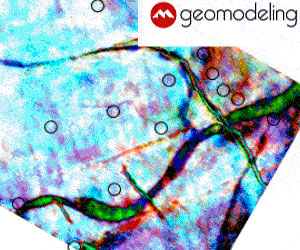Articles

Conversion to Inversion
Oz Yilmaz
The old way of seismic data analysis involves processing, imaging and interpretation – all in the time domain, conducted sequentially. This sequence is then followed by time-to-depth conversion.
...
AVO Attribute Analysis on a Class I Clastic Reservoir
Jon Downton
This paper examines the usefulness of cross-plotting, as a visualization tool, in helping to understand the relationships between different AVO stacks and the presence of hydrocarbons. In particular, this paper will examine a methodology to identify Class I AVO anomalies using the family of AVO stacks based on Smith &…

Improved AVO fluid detection and lithology discrimination using Lamé petrophysical parameters: "λp", "µp", and "λ/µ fluid stack": from P and S inversions
B. Goodway, T. Chen and J. Downton
Traditional AVO and petrophysical analysis extract and exploit anomalous variations between seismic compressional wave velocity (Vp) and shear wave velocity (Vs) to indicate changes primarily in pore fluid, as well as lithologic properties (Gassmann 1951, Pickett 1963, Tatham 1982, Castagna 1993a). Other analysis methods using seismic measurements derive Poisson's ratio…

Sparse 3D, what’s in a name?
Jack Bouska
Recent technical innovation associated with sparse 3D design has resulted in acquisition costs that are substantially lower than both traditional 3D and comparable 2D seismic acquisition expenditures. The Sparse 3D cost/sq. km. price breakthrough has allowed Amoco Canada to pursue Devonian play trends into operationally difficult, heliportable, foothills terrain by…

Deep Sea Gas Hydrates: The Energy of the Future? Deep Sea Studies off Vancouver Island
Roy D. Hyndman
New clean energy sources and global climate change are subjects of much recent discussion. Naturally occurring gas hydrates containing methane may play an important role in both subjects. Hydrates are solid ice-like substances consisting of rigid water molecule cages stabilized by enclosed gas molecules, notably those of hydrocarbons. Gas hydrate…

Transmission filtering by high-amplitude reflection coefficients: Theory, practice, and processing c
Craig A. Coulombe and D. Neil Bird
Over the past few years, Chevron Canada Resources has had an intense and successful exploration effort in the Simonette area of west central Alberta (Figure 1). During our investigations, it was noticed that seismic data in the Devonian section are severely lacking in frequencies above 50 Hz even though the…

Methodology for Seismic Inversion, A Western Canadian Reef Example
John V. Pendrel and Paul Van Riel
Modern seismic inversion methods model both wavelet amplitude and phase effects and offer the opportunity for improved resolution and presentation of data in a form immediately recognizable to both geophysicists and geologists. This has re-focused our attention to the problem of non-uniqueness. Since the bandwidth of the seismic data is…

Discussion Forum
The CSEG Recorder Committee is always looking for and accepting feedback in any form regarding the content of the Recorder. The Recorder is the society's monthly publication, and as such welcomes your comments. The following was submitted from Peter Hubral and Thilo Müller from The Geophysical Institute, Karlsruhe University, Hertzstr.…

Integrating Geology, 3-D Seismic, and Production Data to Optimize Old Oil Pools in the Lower Cretaceous Glauconite Formation, Southern Alberta
Lisa Griffith, Tina Chow, Marc Houle and Brian Zaitlin
Countess O and F Pools (T.18, R.15,16w4) are part of a 535 km long Glauconitic compound incised valley system. Between Countess and Alderson, a 90 km reach of this trend has produced more than 100 Mmbbls oil and 300 Bcf gas from 122 pools. Although in its twilight years of…

Multivariate Geostatistics
Brian Russell and Dan Hampson
Multivariate geostatistics is a broad term that encompasses all geostatistical methods that utilize more than one variable to predict some physical property of the earth. Bivariate geostatistics is obviously the simplest subset of the multivariate techniques and thus the standard technique of cokriging could be called multivariate geostatistics. However, in…

Whither Seismic Imaging?
Samuel Gray
Seismic imaging has evolved to the point where, with sufficient knowledge of the propagation velocities, we can now obtain accurate images, before stack in three dimensions, of almost arbitrarily complicated geologic structures, and we can do this at reasonable cost. That is not to say that we can close the…

Registration (Licensure) of Geoscientists in Canada: A National Perspective and Update
Gordon D. Williams
The registration (licensure) of professionals such as doctors, lawyers, engineers and, increasingly, geoscientists in Canada is the responsibility of individual provinces and territories, under acts of their respective legislatures. These acts limit or restrict the practice of the professions to those persons who are registered (licensed) by autonomous, self-governing professional…

Rock Physics and 4D Seismic for Improved Oil Recovery
Dr. Amos Nur
The worldwide volume of already discovered but unrecovered oil is by now enormous – on the order of (according to some) the oil that still remains to be discovered. On average, only 25% of discovered oil is being recovered in the world, whereas 65% to 75% is considered recoverable. Consequently,…

Geostatistical Depth Mapping: Integration of Seismic Times with Well Tops
David L. Garner
A perpetual exploration problem is to produce depth maps useful for the goals of both geologists and geophysicists and to accurately derive a target depth estimate at a proposed well location. A case history whereby seismic horizon times and well tops are combined to estimate depth using the collocated co-kriging…

Using Technology for E&P Success – the Practices of the Leaders
George Eynon
The western Canadian petroleum exploration and production industry has evolved considerably since the oil price shock of 1986 and the gas price shock of 1990-92. Early adjustments focused on reducing G&A. The second, current phase has an operating emphasis. The primary goal is to meet shareholder objectives - whether those…

Migration Operator Aliasing and its Effect on Interpolation
Peter Cary and Bill Goodway
The controversial topic of 3D spatial sampling and its impact on the final seismic image has generated several articles in the last few years advocating coarsely sampled acquisition geometries (e.g. Neidell, 1994; Goodway & Ragan, 1996). On the other hand, Vermeer (1995) has advocated a fine, "symmetric" sampling geometry in…

Pre-stack Inversion: Evolving the Science ofInversion
Rick Wallace and Roger Young
Over the past 2 decades seismic inversion, ostensibly the process of deriving rock properties from seismic measurements, has evolved significantly. The early methods of recursive inversion converted seismic traces to well log traces providing a measurement of the "pseudo acoustic impedance". The acoustic impedance could also be expressed as "pseudo-acoustic…

One Interpreter’s Most Excellent Adventure
Jan Dewar
Synthetic seismograms are a common tool in geophysical interpretation. They make use of the simple idea of correlating known subsurface information from a well with seismic data recorded on the surface. But sometimes a synthetic seismogram does not match a seismic section very well, and what should be a straight…

Geostatistical Reservoir Characterization of A Canadian Reef Or The Use and Abuse of Geostatistics
Keith Hirsche, Larry Mewhort, Jan Porter-Hjrsche and Rick Davis
Geostatistical methods are becoming widely accepted in reservoir characterization. The appeal of these techniques is the ability to integrate diverse types of information, including seismic data, into a consistent subsurface model. An added benefit of geostatistics over deterministic reservoir description is the ability to assess uncertainty in the modelling process.…

3D Seismic Monitoring for Enhancing Thermal Recovery
John Eastwood, Don Anderson and Tom Boone
A technique is illustrated which uses a single 3D seismic monitor survey along with multiple seismic attributes in conjunction with an offset baseline survey to discriminate heated reservoir from unheated reservoir. 3D seismic monitoring has definitively mapped steam heated regions of the reservoir at two separate geographic locations encompassing more…









